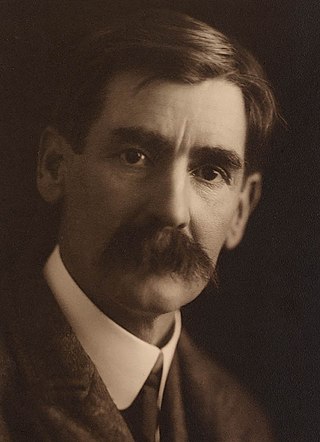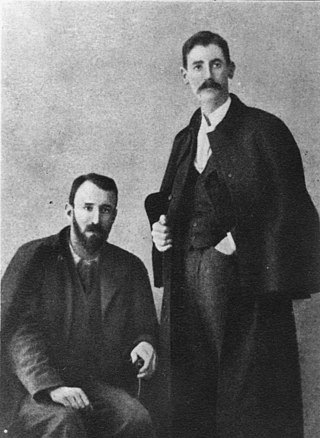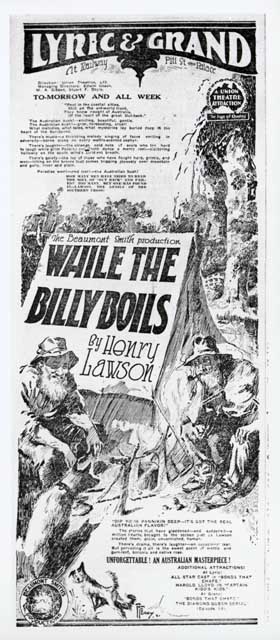Related Research Articles

Henry Archibald Hertzberg Lawson was an Australian writer and bush poet. Along with his contemporary Banjo Paterson, Lawson is among the best-known Australian poets and fiction writers of the colonial period and is often called Australia's "greatest short story writer".

Charles Manning Hope Clark, was an Australian historian and the author of the best-known general history of Australia, his six-volume A History of Australia, published between 1962 and 1987. He has been described as "Australia's most famous historian", but his work has been the target of much criticism, particularly from conservative and classical liberal academics and philosophers.

John Le Gay Brereton was an Australian poet, critic and professor of English at the University of Sydney. He was the first president of the Fellowship of Australian Writers when it was formed in Sydney in 1928.

Australian literature is the written or literary work produced in the area or by the people of the Commonwealth of Australia and its preceding colonies. During its early Western history, Australia was a collection of British colonies; as such, its recognised literary tradition begins with and is linked to the broader tradition of English literature. However, the narrative art of Australian writers has, since 1788, introduced the character of a new continent into literature—exploring such themes as Aboriginality, mateship, egalitarianism, democracy, national identity, migration, Australia's unique location and geography, the complexities of urban living, and "the beauty and the terror" of life in the Australian bush.
A billycan is an Australian term for a lightweight cooking pot in the form of a metal bucket commonly used for boiling water, making tea/coffee or cooking over a campfire or to carry water. These utensils are more commonly known simply as a billy or occasionally as a billy can.
"A Child in the Dark, and a Foreign Father" is a short story by Australian writer and poet, Henry Lawson. The story, often considered to be partially autobiographical, considers the rather bleak relationship between a man and his family.
Joe Wilson is a fictional character appearing in several well-known short stories by Australian writer Henry Lawson. Joe Wilson first appeared in "Brighten's Sister-in-law," the first story Lawson wrote after his arrival to England, and the longest he had ever written up to that time. It was first published in Blackwood's Magazine in November 1900.
"The Union Buries Its Dead" is a well-known sketch story by iconic Australian writer and poet Henry Lawson. The story takes place in Bourke, and concerns the burial of an anonymous union labourer, who had drowned the previous day "while trying to swim some horses across a billabong of the Darling." The narrator, possibly Lawson himself, examines the level of respect the Bushfolk have for the dead, supplementing the story with his trademark dry, sardonic humour.
"A Double Buggy at Lahey's Creek" is a short story by Australian writer and poet Henry Lawson, first published in 1901. It was Lawson's second story to include the character of Joe Wilson; however, chronologically, it is fourth and final in the Joe Wilson series. The story recounts the events that befall Joe Wilson and his family, and which ultimately lead to his buying a double buggy for his wife, Mary.
"On The Edge of a Plain" is a sketch story by Australian writer Henry Lawson, featuring his recurring character Jack Mitchell. The story was originally published in The Bulletin on 6 May 1893, and was collected in While the Billy Boils in 1896. It is considered among Lawson's best Mitchell stories.
A sketch story, literary sketch or simply sketch, is a piece of writing that is generally shorter than a short story, and contains very little, if any, plot. The genre was invented after the 16th century in England, as a result of increasing public interest in realistic depictions of "exotic" locales. The term was most popularly used in the late nineteenth century. As a literary work, it is also often referred to simply as the sketch.
Steelman and Smith are two fictional characters appearing in a series of short stories by Australian writer Henry Lawson.

Randolph Bedford was an Australian poet, novelist, short story writer and Queensland state politician.
Michael Veitch is an Australian author, actor and broadcaster, best known for his roles on the sketch comedy television shows The D-Generation, Fast Forward and Full Frontal, as well as for his books on World War II aviation, marine science and travel.
Ernest Francis "Kodak" O'Ferrall was a popular Australian poet and short story writer born in East Melbourne.
Frank Beaumont "Beau" Smith, was an Australian film director, producer and exhibitor, best known for making low-budget comedies.

While the Billy Boils is a 1921 Australian film from director Beaumont Smith which adapts several stories from Henry Lawson. It is considered a lost film.
"The Drover's Wife" is a dramatic short story by the Australian writer Henry Lawson. It recounts the story of a woman left alone with her four children in an isolated hut in the outback in the late 19th century.

While the Billy Boils is a collection of short stories by the Australian writer Henry Lawson, published by Angus and Robertson in 1896. It includes "The Drover's Wife", "On the Edge of a Plain", and "The Union Buries Its Dead".

Brummy Hewson also known as Brummy Hughson or Brummy Usen is a recurring fictional character in the works of writer and bush poet, Australia's Henry Lawson.
References
- ↑ Manning, Charles (1991) "Henry Lawson", lecture at The University of Melbourne. Collected in Speaking out of turn: lectures and speeches, 1940-1991, Melbourne University Publish (pub. 1997), pp. 181-196
- 1 2 3 4 The Penguin Henry Lawson Short Stories (first published 1986); with an introduction by John Barnes, Camberwell, Victoria: Penguin Books Australia, pp. 1-16, 221-6
- ↑ Henry Lawson (1896) "Enter Mitchell" While the Billy Boils. Angus and Robertson: Sydney, Australia. Retrieved 5 April 2016.
- ↑ Manning Clark (1985) "Heroes" Daedalus, 114(1): Australia: Terra Incognita? (Winter, 1985), pp. 57-84. Retrieved 5 April 2016.
- ↑ Paul Eggert Biography of a Book: Henry Lawson's While the Billy Boils Sydney University Press, p101.
- 1 2 Marilyn Lake (1986) "Historical reconsiderations IV: The politics of respectability: Identifying the masculinist context" Historical Studies, 22(86): 116-131. Retrieved 5 April 2016.